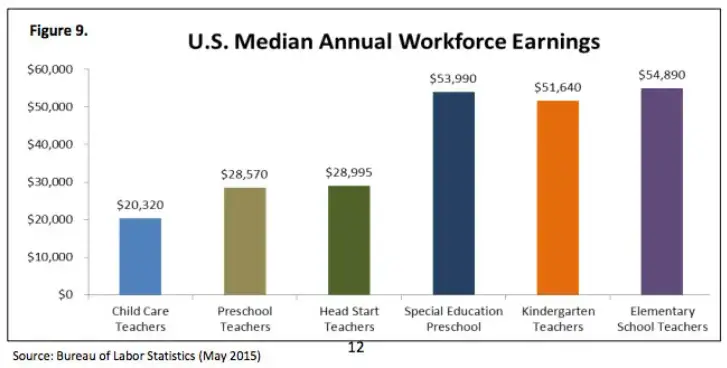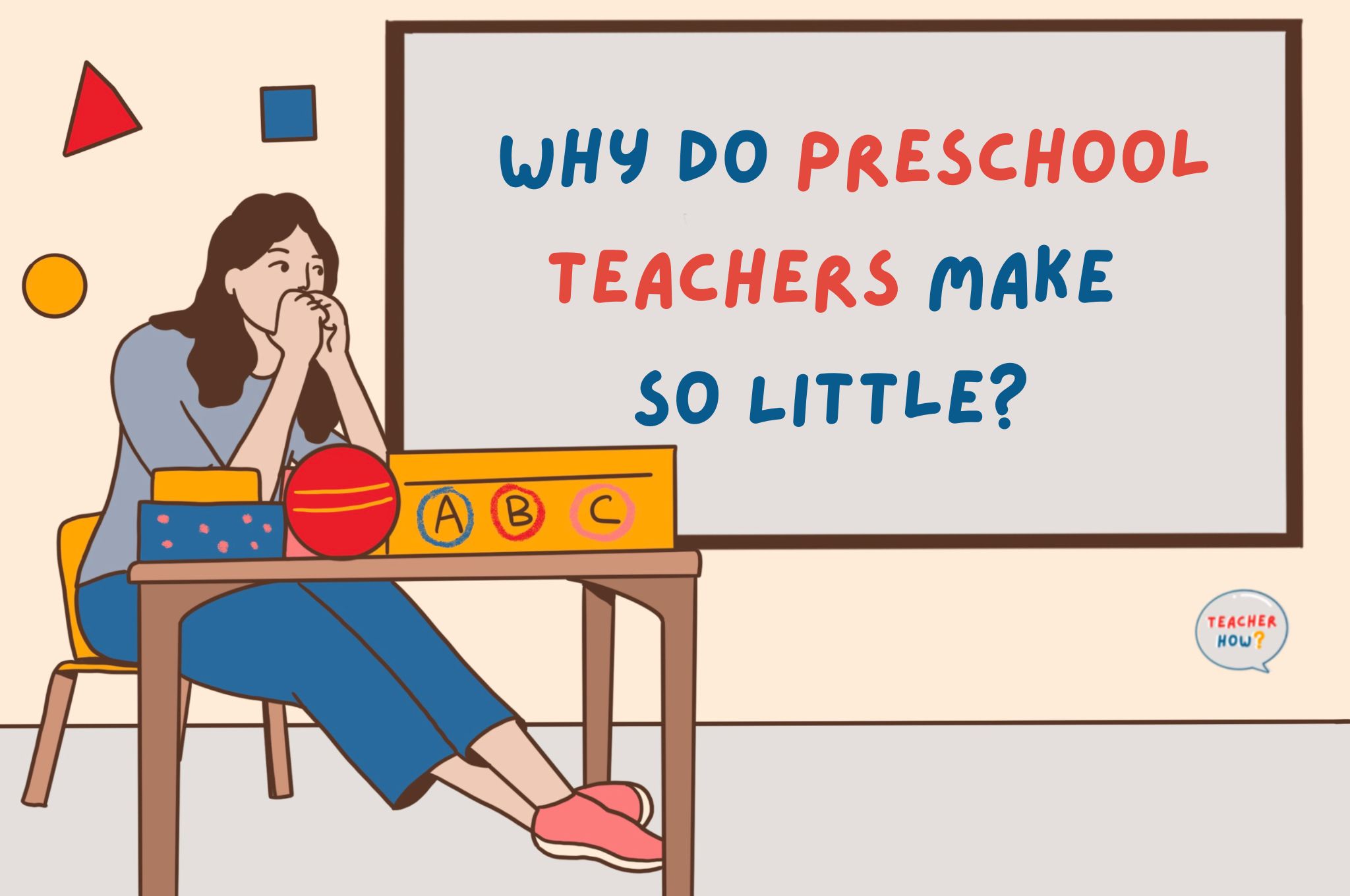Recruiting and retaining effective teachers should be at the forefront of discussions regarding the provision of quality education. And undoubtedly, the topic of salaries dominates the conversation.
While most teachers across the board would argue that they are not being compensated fairly for their time and expertise, preschool teachers seem to have it worse when it comes to pay. So why do preschool teachers make so little?
Preschool teachers generally receive little compared to other teaching professionals. This is mainly due to a lack of public funding brought on by an abject perception of the role of preschool teachers. Wages and conditions for preschool teachers may vary per location, but on the whole, job satisfaction is low.
The rest of this article will explain factors that lead to a low salary turnout for preschool teachers, including current challenges and policy recommendations.
Low Wages of Preschool Teachers
By definition, preschool teachers are responsible for educating children younger than five years old. These children should not have yet entered kindergarten, and the preschool teacher’s primary role is to help them develop their motor, social, and linguistic skills.
As of 2021, the average annual salary of a preschool teacher in the US is $30,210.
The minimum wage for this unique and vital role varies, but according to the U.S. Bureau of Labor Statistics, the median is $14.52 hourly (as of 2021). These statistics mean that the lowest 10% of preschool teachers earn less than $22,000 annually, while those in the top 10% can make more than $58,000.
And even in a post-pandemic world where we have a newfound appreciation for early education teachers – with parents understanding the difficult task of keeping children active and stimulated – preschool teachers still receive an average of only $11 hourly.
American preschool teachers’ federal poverty levels and wages are similar to a donut maker’s fees, ranking between parking lot attendants and those in the dry-cleaning and laundry industries.
Some preschool teachers are also teacher assistants, receiving only a median salary of $16,000 annually.
What is important to note, too, is that the average American preschool teacher’s salary is also less than the median salary of janitors – although the latter only requires a high school diploma.
The National Institute for Early Education Research also reveals that chauffeurs and cooks receive a higher annual salary than preschool teachers. They attribute this to lower teacher morale and turnover among preschool teachers.
Other factors can also alter a preschool teacher’s wage depending on the industry where they work. For instance, some preschool teachers engage in child daycare services, others in the state, local, or private schools, while others render individual and family services for civic and professional organizations.
This YouTube video talks a little more about how the pay for preschool teachers is determined:
To sum up, the low salaries impact preschool teachers significantly, with 40% of these teachers still needing public assistance due to low wages.
Preschool teachers are seven times more likely to live in poverty than their kindergarten teacher counterparts in the public sector – and this problem is further highlighted when we consider how it affects people of color.
Finally, it shouldn’t come as a surprise that preschool teachers earn considerably less on average than other teaching professionals, like elementary and high school teachers.
Although from 2015, the chart below from the U.S. Bureau of Labor Statistics highlights this clearly:

Reasons and Challenges Related to Preschool Teacher Salaries
A greater number of 3 to 4-year-olds are enrolled in public schools compared with private ones. This means that school districts are primarily responsible for teachers’ pay and benefits.
Since not all preschool roles require a bachelor’s degree, employers see this as a fair reason for offering relatively lower pay.
However, the lack of federal funding and uncompromising policies are the key reasons why preschool teachers make so little.
Because of the relatively low salary compared to their peers in other professions, research data reveals that most preschool teachers are prone to leaving their jobs. Studies by Goelman & Guo and Whitebook & Belim cite low salary and benefits and low job status as the top reasons preschool teachers are hard to retain – across countries and cultures.
Below, we discuss these challenges that preschool teachers encounter – in greater detail.
Salary Issues
An Early Childhood Education Journal study reveals that most preschool teachers receive salaries that do not cover their basic expenses.
Given that a teacher’s salary is the most significant factor that makes teachers stay in the education field, it is no wonder their well-being and enthusiasm for the job take a negative turn.
Another issue related to preschool teachers’ salary concerns is quality. Researchers put forward that if school districts continue to fail to ensure decent compensation, the quality of early childhood education will continue to erode – directly and indirectly harming children.
In essence, high-quality teachers will continue leaving the field due to low pay, and institutions will be forced to hire subpar (or unqualified) teachers to fill their spots and work for less pay.
Policy Challenges
Despite high expectations from preschool teachers (including state-funded targets) to perform well – especially in providing rich learning experiences for children – they still need to get return pay and benefits similar to their K-12 peers.
As such, there is a need for more direction in state preschool programs to solve issues like inadequate funding.
On top of that, even in states like Michigan and Georgia that require additional credentials and a bachelor’s degree in preschool teachers’ credentials, there are still significant salary gaps when comparing teacher qualifications and pay to K-12 teachers.
Moreover, a report states that regarding non-salary benefits (e.g., paid time off, healthcare, retirement), only one state has provisions for preschool teachers.
Concerning compensation parity, only four states have policies that enable complete pay equality for their preschool teachers. A pattern that The National Institute for Early Education Research highlights is that preschool teachers from public schools tend to have this pay parity but not for private sectors.
Aside from compensation, research also highlights differences in the number of sick and vacation days. Reportedly, elementary school teachers – working in the same state – receive more sick and vacation days than their preschool teacher counterparts.
Researchers thus call for revisiting this concern so that schools can address preschool teacher turnover and burnout.
Well-Being Concerns
There are various registrations, licenses, and certificates that one must secure to be a preschool teacher, making the salary gap an issue that is not just about pay but also about well-being.
Some states require credentials like Child Development Associate (CDA) recognition, which requires field experience and a written exam. It’s also a certification that the teacher must renew every three years.
Other states require a bachelor’s degree and another competency exam. On top of that, preschool teachers need to demonstrate various skills and important qualities, including physical stamina to work with children, patience, and creativity.
Preschool teachers must also showcase excellent organizational, interpersonal, and communication skills.
It is no longer surprising that studies report multiple stress factors and burnout across preschool teachers, including overall dissatisfaction with the job.
Put yourself in the shoes of a preschool teacher who is responsible for helping young children learn experimentation, playing, and problem-solving.
It is crucial to revisit these issues concerning well-being as an increasing number of preschool teachers exit the workforce or transfer to different occupations.
Suggestions To Address the Low Pay of Preschool Teachers
It is high time to address this concern, especially amidst the high living costs and lack of health insurance. One can’t expect teachers to care for their children if these teachers can’t even support their families.
Various studies approach the matter of preschool teachers’ pay and workload differently. A study in the Romanian educational system suggests a salary increase and reducing the number of students to handle per group.
There are calls for policy changes regarding state funding and revisiting teacher qualifications in the U.S. For one, there is a clamor to level preschool teachers’ salaries with those from K-12 public schools – noting annual increases in funding.
There is also a recommendation for state subsidization of preschool teachers, especially ensuring adequate pay and benefits.
On a related note, a study by Cassidy et al. suggests that childcare program directors should also consider salary and benefits increase when recognizing their link to teacher turnover and financial stability. They argue that these teacher wage enhancements will positively impact children’s classroom experiences regarding behavior and academic progress.
With a growth projection of 15% in preschool teacher employment in the U.S. in the coming decade, as well as more than 60,000 projected openings, there is a need to make these recommendations happen.
The most significant thing that the literature on preschool teachers makes clear is that if we want to support our children in their early childhood classrooms, their early childhood carers and teachers must also receive adequate financial and emotional support.
We must also note that if this problem is unsolved, fewer people will be pursuing early childhood degrees. Much of our childcare system depends on our preschool teachers, so we must find ways to help them get the professional benefits and compensation they deserve.
Conclusion
We can still do many things to improve preschool teachers’ salaries and the quality of early childhood education. Significant research findings tell us the following:
- Studies reveal that teachers tend to leave primarily due to low salaries.
- Besides salary, part of retaining preschool teachers and their quality is ensuring high job satisfaction with a focus on well-being.
Schools and administrators should work on reassessing teacher salaries and providing avenues for preschool teachers’ growth. This involves how they foster positive interactions with kids, collaborate with peers, receive support from supervisors, and work under reasonable conditions that enable promotions.
There is positive news, however, as in April 2021, President Biden announced the American Families Plan, which aims to implement universal pre-schooling for all 3 and 4-year-olds, and ensure a $15 minimum hourly wage for childcare workers.
Whether the plan is enough to solve the issues faced by preschool teachers in the near future remains to be seen.
Sources
- US News: How Much Does a Preschool Teacher Make?
- Statista: Number of 3 to 4 year old children enrolled in public and private schools in the United States from 1980 to 2018
- NIEER: Low wages= low quality: Solving the real preschool teacher crisis
- NIEER: Unworthy Wages: State-Funded Preschool Teacher Salaries and Benefits
- ScienceDirect: Stress Factors and Solutions for the Phenomenon of Burnout of Preschool Teachers
- Springer: Preschool Teachers’ Financial Well-Being and Work Time Supports: Associations with Children’s Emotional Expressions and Behaviors in Classrooms
- ScienceDirect: Predicting preschool teacher retention and turnover in newly hired Head Start teachers across the first half of the school year
- YouTube: How Much Should You Pay Preschool Teachers
- U.S. Bureau of Labor Statistics: Occupational Outlook Handbook: Preschool Teachers
- Brookings Institution: Are our preschool teachers worth more than they were two months ago?
- Child Care Services Association: It’s Long Past Time Early Childhood Teachers Earned a Worthy Wage
- The White House: The American Families Plan

